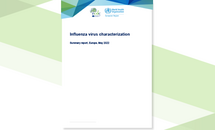Influenza virus characterisation - Summary Europe, July 2021
This is the ninth report for the 2020-2021 influenza season. As of week 28 /2021, only 943 influenza detections across the WHO European Region had been reported to the European Surveillance System (TESSy); 51% type A viruses, with A(H3N2) and A(H1N1)pdm09 being approximately equally represented, and 49% type B viruses with only 16 having been ascribed to a lineage, 13 B/Victoria and three B/Yamagata. This represents a 99.4% drop in detections compared with the same period in 2020, probably due to measures introduced to combat the COVID 19 pandemic.
Executive Summary
Since the June 2021 characterisation report report, one shipment from an EU/EEA country (France) containing six virus isolates was received at the London WHO Collaborating Centre, the Francis Crick Worldwide Influenza Centre (WIC): virus characterisation of these six viruses is ongoing. This report therefore focuses on genetic characterisation of the HA genes of seasonal influenza viruses submitted and/or released in GISAID during July 2021, together with sequences recently determined at the WIC. The data continue to show extremely low levels of influenza detections globally.
The 60 A(H1N1)pdm09 HA sequences derived from viruses detected in 2021 as deposited/released in GISAID during July, all originated in Togo and were subgroup 6B.1A5A+187V/A , represented by the vaccine virus for the northern hemisphere 2020 2021 season, A/Guangdong Maonan/SWL1536/2019 . Most of these sequences (35) encoded additional HA1 amino acid substitutions of I166T and A186T.
All 57 HA sequences that became available in July for A(H3N2) viruses , detected in fell in subgroup 3C.2a1b+T131K A. The viruses in this subgroup split into two antigenically distinguishable clusters originally defined by viruses from Cambodia ( n = 1 3 : with HA1 amino acid substitutions of G186S, F193S, Y195F and S198P, many also having K171N ) and Bangladesh n = 4 4 : with HA1 amino acid substitutions of Y159N, T160I (loss of a glycosylation site), L164Q, G186D, D190N, F193S and Y195F) with Bangladesh-like viruses showing the greatest geographic spread. The seven viruses from EU/EEA countries were Bangladesh like. An A/Cambodia/e0826360/2020 like virus (subgroup 3C.2a1b+T131K A) has been recommended for use in the 2021 2022 northern hemisphere influenza season.
The 45 B/Victoria lineage HA sequences derived from viruses collected in 2021 that became available in July were subclade 1A( 3)B Of these, 10 from Kenya were equally split between groups defined by HA1 G133R substitution or HA1 K75E, E128K, T155A, G230N and I267V substitution. All other sequences were from N150K group viruses with HA1 amino acid substitutions of N150K, G184E, N197D (loss of a glycosylation site) and R279K. N150K group sequences split into two subgroups one of which, defined by HA1 substitutions V220M and P241Q, was confined to viruses detected in China (n = 2) while the second (n = 33 sequences), defined by HA1 substitutions A127T, P144L, and K203R (with two having additional substitutions of T182A, D197E and T221A), showed significant geographic spread. The four viruses detected in EU/EEA countries all fell in the latter subgroup but lacked the additional amino acid substitutions, as was the case for a set of 19 viruses collected in Singapore in June. Antigenically, viruses in subgroups of the N150K group differ and show some loss of reactivity with post-infection ferret antisera raised against the B /Washington/02/2019 vaccine virus (recommended for inclusion in influenza vaccines for the 2020-2021 and 2021-2022 northern hemisphere seasons and 2021 southern hemisphere season). This was clearly the case for the three N150K group viruses from Sweden characterised by HI in the June report.
No B/Yamagata-lineage HA sequences from clinical specimens collected in 2021, and none with collection dates after March 2020, were available. All of the 77 sequences from viruses detected in 2020, inclusive of 12 from EU/EEA countries, belong to genetic clade 3 and carry three HA1 amino acid substitutions (L172Q, D229N and M251V) compared with B/Phuket/3073/2013-like viruses which have been recommended for use in quadrivalent influenza vaccines for the 2020-2021 and 2021-2022 northern hemisphere seasons and 2021 southern hemisphere season. The antigenic effects of these amino acid substitutions have been minimal, as assessed in earlier reports.
Download







